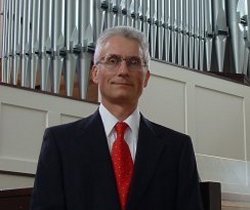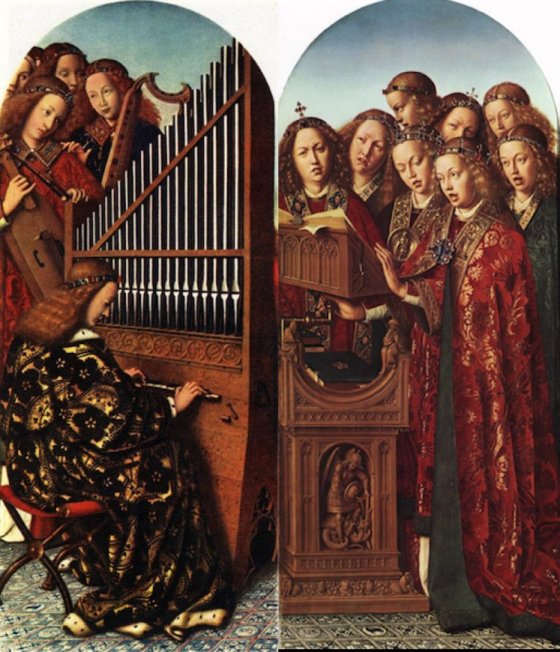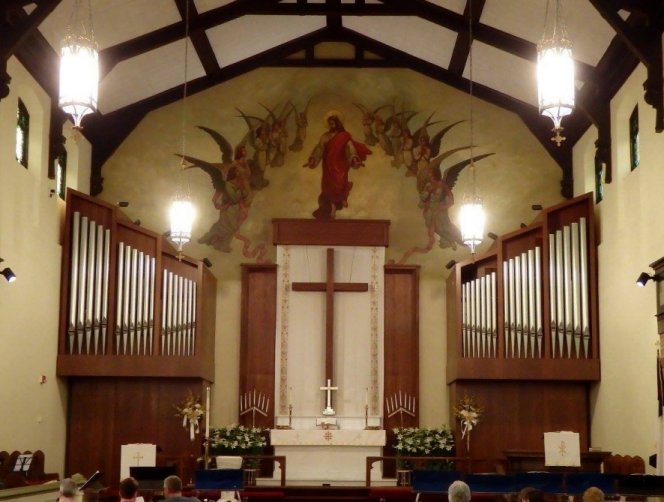
| | Organist | Accordionist | Composer | Conductor | Author | Educator |
an essay by Henry Doktorski

 |
Henry Doktorski
an essay by Henry Doktorski |
 |
Reprinted from the "Grace Visitor" (September 2015), a monthly publication of
Grace Evangelical Lutheran Church, Rochester, Pennsylvania.

Jan van Eyck, Musical Angels, two panels from the Ghent Altarpiece, 1430-32, oil on panel.
“The organ has always been considered, and rightly so, the king of musical instruments, because it takes up all the sounds of creation . . . and gives resonance to the fullness of human sentiments, from joy to sadness, from praise to lamentation. By transcending the merely human sphere, as all music of quality does, it evokes the divine. The organ’s great range of timbre, from piano through to a thundering fortissimo, makes it an instrument superior to all others. It is capable of echoing and expressing all the experiences of human life. The manifold possibilities of the organ in some way remind us of the immensity and the magnificence of God.”—Pope Benedict XVI, Blessing of the New Organ at the Basilica Alte Kapelle in Regensburg, Germany (September 13, 2006).
Although, in today’s modern age of guitars, hip hop, rap, and rock music, many might disagree with Pope Benedict’s high esteem for the pipe organ—called “The King of Instruments” by celebrated composers such as Guillaume de Machaut (c. 1300-1377) and Wolfgang Amadeus Mozart (1756-1791), to name a few—we cannot forget that for much of the history of the Christian church in Europe (and more recently, America) from the 11th through the 20th centuries the pipe organ held the most prominent position amongst all musical instruments.
One of the reasons, perhaps, for the great popularity of the organ is its superb ability to support the congregation during the singing of chants and hymns. More than any other instrument, the organ has (1) a great depth and richness of tone, (2) a sustaining or “singing” quality (organ pipes “speak” when air is supplied by a wind chest, just as our vocal cords speak when air is supplied by our lungs), and (depending on the size of the instrument) (3) a tremendous range of dynamics from a whispering pianissimo to a deafening fortissimo.
At Grace Evangelical Lutheran Church in Rochester, Pennsylvania, we are blessed to have an excellent and well-maintained pipe organ designed and built by the Schlicker Organ Company (founded in 1930 by Herman L. Schlicker). The acquisition of the 29-rank 1983 Schlicker organ was due essentially to the generosity of one person: Marjorie Shane (1912-2011), a graduate from the Oberlin Conservatory of Music who served in many musical capacities at Grace for more than six decades.
Harry Baker, a leader at Grace Lutheran for many years who served multiple terms as vice-president and treasurer of the Parish Council, explained, “Our Schlicker organ was purchased for $120,940, in no small measure due to Marge Shane, who had been involved with music at Grace for sixty-one consecutive years. Marge directed or sang in the choir, served as the organist, or directed the adult hand bell choir. Marge also directed the junior and primary youth choirs. During that time, all of her salary she gave back to the church. The church kept that money in a special fund, and that fund was the primary source of funding when a successful pledge drive was started and with it, enabled the purchase of our 1983 Schlicker organ.”
With the funding from Mrs. Shane and the pledge drive, Grace Lutheran purchased a medium-size instrument from the Schlicker Organ Company with two 61-key manuals, a 32-note pedalboard and 29 ranks consisting of 1,590 pipes. (The smallest portative organs may have only one manual and one or two dozen pipes; the largest municipal auditorium organs may have seven manuals and over 20,000 pipes.) I think our organ is perfectly suitable for the size of our church, although, I sadly admit, when carpeting was installed a few years ago the volume of the organ was noticeably diminished because the carpet reduced the hard reflective surfaces which formerly allowed the organ’s sound to reverberate throughout the building.

The Great and Swell Divisions of the 1983 Schlicker organ at Grace Lutheran Church, Rochester, Pennsylvania.
The Grace Lutheran organ stop list contains representatives from all four families of organ pipes—Principal pipes, Flute pipes, String pipes and Reed pipes—as well as chimes.
Principal Stops
8-foot Principal
4-foot Octave
2-foot Principal
Sesquialtera II
1 1/3 Kleinnasat
Scharf III
Mixture IV
8-foot Offenbass (in pedal)
4-foot Choral Bass (in pedal)
Mixture III (in pedal)Flute Stops
8-foot Bourdon
8-foot Rohrfloete
4-foot Koppelfloete
4-foot Spitzfloete
2-foot Blockfloete
16-foot Subbass (in pedal)
8-foot Gedackt (in pedal)String Stops
8-foot Salicional
8-foot Voix CelesteReed Stops
8-foot Trompete
The Grace Lutheran organ consists of essentially three parts: the console in the choir loft (where the organist sits) and two divisions of pipes located against the back wall of the sanctuary. The cabinet on the left (as you face the altar) is called the Great Division and the cabinet on the right is the Swell Division. The pipes in the Great Division are unenclosed: they speak directly into the Nave. On the other hand, the pipes in the Swell Division are enclosed: the volume of the pipes is softened because they are shut up in a wooden box with shutters that face the congregation. When the shutters are opened (controlled by a foot pedal at the console) the full volume of sound reaches our ears unobstructed, and when the shutters are closed, the sound is muffled and softened. The shutters of the Swell Division allow the organist to vary the expression or dynamics (volume).
8-foot Cromorne
16-foot Fagott (in pedal)
8-foot Fagott (in pedal)
4-foot Fagott (in pedal)("Fagott" is the German word for "Bassoon," meaning literally "a bundle of sticks.")
The Pedal Division of pipes is physically located in both the Great and Swell Divisions. The Principal and Flute pedal pipes (up to eight feet in length) are located in the Great Division, while the Reed pipes (up to sixteen feet in length) are located in the Swell Division.
Our organ at Grace Lutheran is also unusual and unique—it has two separate ranks of chimes: one inside the Swell Division with 21 tubes (played on the Swell manual) and another outside hanging on the wall in the choir loft with 25 tubes (played on a separate manual to the right of the console). This allows the organist to create antiphonal effects with the chimes, as each rank has a different and easily-identifiable timbre. For special festive events, such as during the Christmas season, I like to feature the two ranks of chimes in our music. To hear a piece of music which features our two ranks of chimes (as well as the trumpet stop and the full tutti organ), Click Here.
One of the reasons for the popularity of the pipe organ in Christian churches and cathedrals for nearly a thousand years, as I mentioned earlier, is its superb ability to support the congregation in hymnody. For the most part, classic hymns are written in a style which makes them easy to sing. The poetic meter is regular and consistent, the melodic rhythms are fairly predictable, there is little or no syncopation (unexpected off-beat accents), the vocal range of pitch is modest, and the tunes are usually simple.
Does this mean that classic hymn tunes are banal or lacking in artistry? No, quite the contrary. Classic hymn tunes often express a beauty and genius of composition despite their simplicity. One Medieval saint explained that things of beauty don’t have to be complicated; simplicity can equate with artistry and eloquence, “Essential truth spoken concisely is true eloquence.” (Sri Caitanya Mahaprabhu of Bengal, India [1486-1534])
This simple and eloquent style of hymn writing proved perfect for worship for the last thousand years, especially considering that during much of that time many churchgoers had little or no education, training in the art of singing, or even ability to read or write. This classic style of hymn writing has stood the test of time. In fact, some of the hymns in our Lutheran Book of Worship feature texts written as early as the second century and music composed as early as the 13th century. (Not to mention the Psalms, which may have been written around 1000 BCE.)
Today, however—beginning with the liturgical reforms of the Second Vatican Council in the 1960s which attempted to modernize the Roman Catholic liturgy and make it (possibly) more relevant to citizens of the mid-20th century—popular styles of music, such as rock and folk music (which are, in my opinion, notorious for texts with irregular and inconsistent meter, and syncopated melodies which sound best with accompaniment by percussive instruments such as guitar, piano, and drums) have become increasingly popular in many churches in the West. At Grace Lutheran, many parishioners attend our more-informal 8:30 a.m. early service, during which worshippers sing mostly contemporary pop-style songs with piano accompaniment, and they seem to really enjoy it.
Recent surveys have indicated that this trend toward pop-style music in church will probably continue: more and more churches in America have sold their pipe organs, disbanded their choirs and trashed their old hymnals and replaced them with guitars, electronic keyboards, drums, large video screens to project song lyrics and charismatic hand-clapping song-leaders. The organ, unfortunately, cannot accompany syncopated pop-style tunes as well as it can accompany traditional hymn tunes. What will the future hold? Will the church organ face extinction, only to be heard in musical instrument museums? Time will tell. But at least for the time being, worshippers at Grace Lutheran’s second “high” service can still become inspired by singing time-honored traditional hymns with accompaniment by the “king of instruments.”
For more about Grace Lutheran Evangelical Church of Rochester, Pennsylvania, Click Here.
|